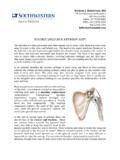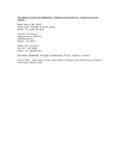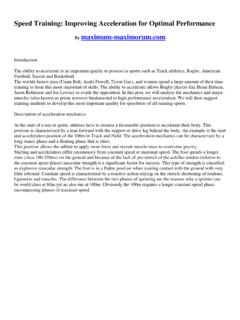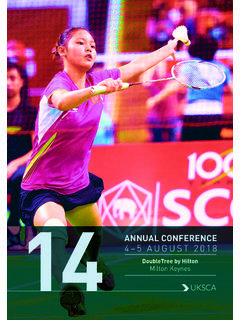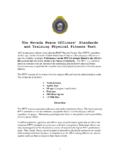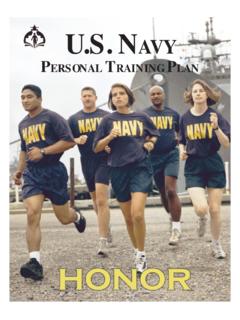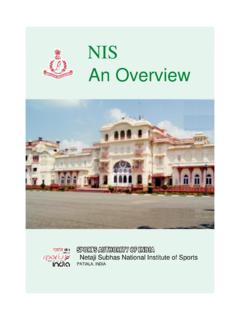Transcription of William J. Robertson, MD TMI Sports Medicine Fax: …
1 Anterior Cruciate Ligament Reconstruction Postoperative Rehab Protocol You will follow-up with Dr. Robertson on the 1st day after surgery where he will review your operative findings and restrictions. At this office visit you will also see one of his physical therapists. At that time, they will perform an assessment, review several exercises, and help you develop a plan for further rehabilitation. This handout serves as a guideline for your rehabilitation after anterior cruciate ligament reconstruction. You may vary in your ability to do these exercises and to progress from one phase to the other.
2 Please call Dr. Robertson's office if you are having a problem with your knee or need clarification regarding the rehab protocol. This rehab protocol can be found at Phase 0: Pre-Operative Recommendations Normal Gait AROM 0 to 120 of flexion Strength: 20 SLR with no lag Minimal effusion Patient education on postoperative exercises and need for compliance, including isometric quadriceps, heel slides, prone hangs, and SLR in brace locked at 0 Postoperative Phase I: Immediate Postoperative Phase (Weeks 0 to 2) Goals Achieve range of motion 0 to 90 with emphasis on passive extension Control postoperative pain/swelling Independence with home exercise program Precautions Avoid active knee extension 0 to 40 General Principles Weight-bearing status for all graft types: William J.
3 Robertson, MD TMI Sports Medicine 3533 Matlock Rd Arlington, TX 76015 Office: (817) 419-0303 Fax: (817) 468-5963 WBAT with crutches in brace locked in extension. May unlock brace for sitting. (This may vary in revision cases). Crutches: may be discontinued when pain tolerates and able to safely ascend/descend stairs without notable pain Passive ROM: The therapist will show you exercises such as heel slides and well-leg stationary bike that will start getting your knee moving immediately. Cryotherapy: Polar care or ice used for first week and then PRN Brace: Post-op brace may be unlocked 0-90 for ambulation at 2 weeks post-op The brace may be discontinued when the patient can perform 20 reps of SLR without a lag (typically 3-4 weeks post-op).
4 Treatment Plan Extension: low load, long-duration stretching (heel prop, prone hang) Flexion: wall slides, heel slides, stationary bike (rocking for range) Patellar mobilization Strengthening: SLR emphasizing no lag (first start in brace locked in extension), Quad sets (with electrical muscle stimulator), leg press, hamstring curls, prone hip extension, sidelining hip abduction/abduction (avoid stress on MCL if concomitant MCL injury), ankle pumps with theraband, heel raises Criteria for Progression to Phase II Ability to SLR without quadriceps lag Demonstrates the ability to unilateral (involved extremity) weight bear w/o pain ROM 0 to 90 Postoperative Phase II (Weeks 2 to 6)
5 Goals ROM 0 to 125 Good patellar mobility and minimal swelling Restore normal gait Ascend 8 inch stairs with good control and without pain Precautions Avoid pain with therapeutic exercise and functional activities Treatment Plan Discontinue crutches when gait is non-antalgic Brace: Brace unlocked from 0-90 degrees. To be worn for ambulation and during therapy exercises as above. Convert to knee sleeve or other specified functional brace during PT exercises at 6 weeks. To be worn for PT exercises and return to sport for the first year. Strengthening: Quad sets, wall squats, step ups, leg press (0 to 80 arc), SLR's, active knee extension from 90 to 40 , hamstring curls, resisted hip extension with bands, hip adduction/abduction, heel raises.
6 Proprioception training with balance board Stationary bike, Alter-G ambulation / gait training Home exercise program Criteria for Progression to Phase III ROM 0 to 125 Normal gait pattern Demonstrated ability to ascend 8 inch step Postoperative Phase III (Weeks 6 to 14) Goals Restore full ROM Functional strength and control with ADLs Demonstrate ability to descend 8 inch stairs with good control and without pain Precautions Avoid pain with therapeutic exercise and functional activities Avoid running and sport activity until adequate strength development and surgeons clearance Knee sleeve or other specified functional brace during PT exercises at 6 weeks.
7 To be worn for PT exercises and return to sport for the first year. Treatment Plan Progress squat program Initiate step down program Elliptical trainer, stairmaster at 8 weeks Strengthening: leg press, lunges, isotonic knee extensions 90 to 40 , Advance proprioception training (perturbations) Treadmill ambulation/ Alter-G Jogging at 14 weeks (No cutting or pivoting) Jogging on a treadmill at 3 months Agility exercises ( Sports cord) Home exercise program Criteria for Progression to Phase IV Running without pain or swelling Hopping without pain or swelling (bilateral and unilateral) Demonstrated ability to descend 8 inch step with good leg control and w/o pain Postoperative Phase IV (Weeks 14 to 22)
8 Goals Demonstrate ability to run pain-free Maximize strength and flexibility to meet demands of ADLs Hop test 75% limb symmetry Precautions Avoid pain with therapeutic exercise and functional activities Avoid running and sport activity until adequate strength development and surgeons clearance Knee sleeve or other specified functional brace to be worn for PT exercises and return to sport for the first year. Treatment Plan Start forward running (treadmill) program when 8 inch step down is satisfactory Continue lower extremity flexibility and strengthening program At 5 months, advance agility program (shuffling, hopping, carioca, vertical jumps, running patterns at 50 to 75% speed, initiate sport specific drill patterns at 50 to 75% effort).
9 Knee sleeve or Functional brace in place. Isotonic knee extension (full arc) Continue proprioception training (perturbations) Home exercise program Criteria for Progression to Phase V Symptom-free running Hop test 75% limb symmetry Postoperative Phase V (Weeks 22 and Beyond) Goals Sport specific training without apprehension, pain, swelling or difficulty Maximize strength and flexibility to meet demands of sport Hop test 85% limb symmetry Precautions Avoid pain with therapeutic exercise and functional activities Avoid running and sport activity until adequate strength development and surgeons clearance Treatment Plan Continue to advance lower extremity strengthening, flexibility, and agility programs Advance plyometric program Knee sleeve or other specified functional brace to be worn for sportive activities for the first year.
10 Sport specific activities interval training running patterns in football sprinting change of direction pivot and drive in basketball kicking a soccer spiking in volleyball Home exercise program Patients wishing to return to Sports or high demand activities before 8 months post-op should undergo an ACL Functional Test by a TMI Physical Therapist at 6 months post-op and then discuss the results with Dr. Robertson. Criteria for Discharge Hop test 85% limb symmetry Lack of apprehension with sport specific movements Confidence when running, cutting, jumping at full speed

